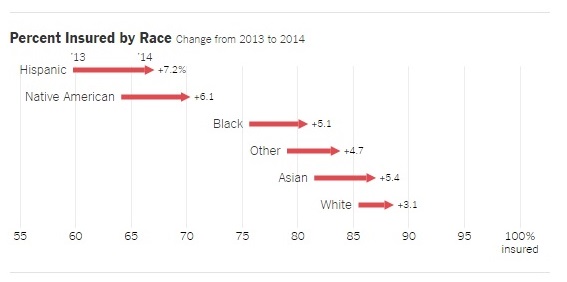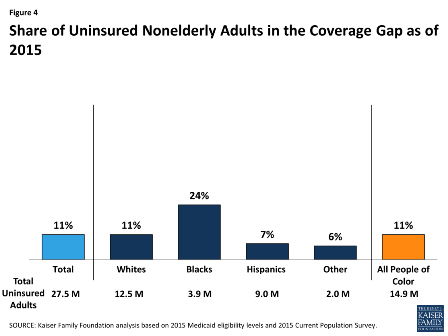The fourth in our National Minority Health Month blog series.
For National Minority Health month, we are celebrating the 32 states including the District of Columbia that have chosen to close the coverage gap. Not only have these states extended health insurance to millions of low-income working families, they have also reduced stubborn health care disparities experienced by communities of color.
Remarkable Gains in Coverage Among Communities of Color
Historically, communities of color were much more likely to be uninsured compared to Whites (see Figure 1). One in three Latinos and Native Americans, as well as one in five Blacks did not have insurance compared to one in seven Whites. Likewise, Black and Latino adults were less likely to have a usual source of care and more likely to skip getting care because of costs.

Figure 1: Coverage gains by ethnicity pre and post ACA. Source: NYTimes, 2016
The ACA has lifted rates of insurance for adults of color at a rate that outpaces the gains in coverage among Whites (see Figure 1). These improvements have been much greater in states that accepted federal dollars to close the coverage gap than in those that did not. Some clinics in states that have closed the gap have reported seeing an uptick in patients of color using preventive services. In one health clinic in California, a vast majority of new patients are people of color who are newly eligible for Medicaid. As a result of more patients having insurance, the clinic has seen a 44 percent increase in cervical cancer screenings, a 25 percent increase in tobacco cessation therapy, and a 22 percent increase in the share of patients with controlled hypertension since 2014.
Despite these outstanding gains in coverage and coverage disparities reduction, 19 states are continuing to leave 3 million adults in the gap; over half are adults of color. Uninsured Black adults are nearly twice as likely as both White and Latino uninsured adults to fall in the coverage gap (see Figure 2), mainly explained by the fact that 60 percent of poor uninsured Blacks live in states that have so far chosen not to increase Medicaid access.

Figure 2. Source: KFF, 2015.
With many racial and ethnic groups still behind their White peers in insured rates as indicated in Figure 1, closing the coverage gap is a critical first step in reducing longstanding disparities in health.
Voices of Minorities Are a Key Part of Close the Gap Campaigns
Communities of color have been an integral part of state campaigns to close the coverage gap. Here are some exciting examples:
- In Virginia, consumer health advocates are partnering with African American faith organizations and churches to make a unified, faith-based push to compel their state leaders to close the coverage gap. Virginia Consumer Voices for Healthcare (VCV), with its parent organization - the Virginia Interfaith Center for Public Policy (VICPP), delivered a letter to legislators, signed by more than 300 faith leaders, calling out the moral imperative for closing the gap and continues to target minority faith leaders for additional sign-on letters. VCV/VICPP is providing education and outreach to faith and other organizations representing communities of color on policy issues relating to expanded Medicaid access.
- In Florida, where 27 percent of Latinos are in the coverage gap, National Council of La Raza (NCLR) conducted an intensive communications and advertisement campaign during last year’s legislative special session. They aired 300 television and radio advertisements in key Latino radio markets featuring spokespeople from the Latino faith and business communities who highlighted the moral and economic responsibility that state representatives have to increase health access. The ads encouraged listeners to call their state representative to support expansion during the legislative session, particularly to increase pressure on “moveable” Latino state representatives. Although the state did not close the gap, the effort drummed up lots of media attention and put hundreds of constituents in contact with their representative. They were also able to move a moderate Latino Republican to support closing the gap during the session.
Extending coverage to more people in the remaining 19 states would continue to drive down health disparities among working adults of color who are more likely to face problems paying medical bills and who, therefore, more often delay and forgo needed care. We hope that by this time next year when National Minority Health Month comes around, coverage inequities will be further reduced thanks to more states having closed the coverage gap!
